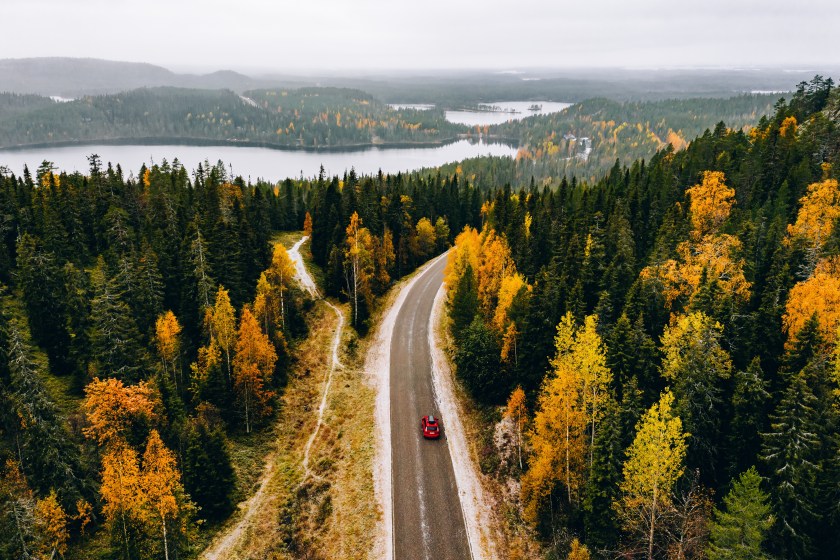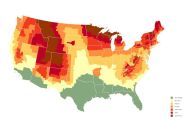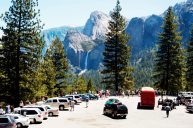With fall just around the corner, many people are heading back to school, breaking out their sweaters, and beginning to hunker down. But the space between the splashy antics of summer and winter's snowy wonderland can actually be one of the best times for nature-inspired travel, especially in places where the leaves put on a show.
I should know—I've worked several seasons as a Park Ranger along the Blue Ridge Parkway, a 469-mile-long scenic drive through the Southern Appalachians that's renowned for its fall foliage and iconic autumnal color.
But, at least among locals, the Parkway also has a reputation for bumbling tourists ensnared in traffic jams, dangerous pedestrian antics, and even serious motor vehicle accidents. The same can be said for any major leaf-peeping destination across the U.S., from roads full of the golden aspens of Colorado to Northern Wisconsin's red oaks and bronze hickories.
With a bit of intention and foresight, time spent in any prominent leaf-viewing area this season can have a little more color—and a little less frustration.
1. Call or Check Websites in Advance
Because fall color change is dependent on several external factors, it can be hard to predict the perfect time to visit without a little pre-planning. Many parks, scenic roadways, and even geographic regions have their own algorithmic maps, which provide insight into where color is peaking.
The Smoky Mountain interactive fall foliage map is one such resource. It uses historical temperature and meteorological data, forecasted temperatures, and user-generated reports to plot peak color change across the United States from September to November.
2. Check the Weather and Road Closures

Getty Images, wmaster890
Helping visitors navigate leaf-peeping hot spots is usually a ton of fun, but the worst part of the job is telling excited visitors that a certain segment of park or road is closed at the time of their visit.
In the Rockys, where much of peak fall foliage occurs, winter can come as early as September, closing mountain passes favored by leaf peepers. Even in the southeast, winter conditions can surprise you: For example, in order to protect surrounding plant life, crews don't salt or plow roads along the Blue Ridge Parkway, so early cold at higher elevation can often force closures or detours.
Of course, regulations may vary from state to state, so it's best to check your intended destination a day or two in advance. Speaking with someone at a specific location can also help you navigate things like distance between gas stations and pit stops, cell service (or lack thereof), and general driving conditions for the time of year you're visiting.
3. Drive The Speed Limit

Getty Images, borchee
You've got your location dialed in. You've got specifics on the road that will take you there. It's time to see some color!
Believe it or not, the hunt for fall foliage doesn't magically change the rules of the road.
It may sound simple, but when you hop in the car, do your best to observe the speed limit. That means, of course, not mindlessly zooming through scenic areas where tourists might congregate, but it also means not crawling along so slowly that cars pile up behind you. Both of these things can—and do—result in accidents.
If you'd like to drive slowly, utilize the pullout system whenever possible to let faster traffic pass by.
4. Remember: The Road Is Not a Parking Lot
If you're headed to a scenic roadway or a park this fall, stop by the visitor center and ask an employee to mark some of the most picturesque pull-outs or trailhead parking areas on a map. Most places that feature scenic leaf displays have designated areas for visitors to stop and enjoy the view. That way, you can plan your intended stops instead of spontaneously trying to navigate the narrow shoulder of a two-lane mountain road while cars hurry around you.
Remember: The road is not a parking lot!
5. The Road Is Not a Seflie Spot, Either

Getty Images, oatawa
A word of caution for pedestrians: while the road is not a parking lot, the road is not a hiking trail or a selfie-taking spot, either. Many areas where fall foliage occurs are on remote and winding mountain roads, and drivers are often looking at the leaves around them as much as they're looking at the road ahead of them. Don't mindlessly walk into the center of the road for a picture.
Many areas renowned for fall leaf displays are also popular outdoor recreation areas. Keep in mind that cars, motorcyclists, bikers, hikers, and walkers will all be sharing the same facilities. Bicyclists and motorcyclists must follow the same rules as motor vehicles while on the road, while pedestrians always have the right-of-way.
If someone is moving more slowly than you are, give them the opportunity to use a pullout so you can pass by. If no pullout is available, wait until you have a clear sightline and pass carefully, granting at least three feet of clearance between you and the other vehicle.
6. Go on the Weekdays
If you have some flexibility in your schedule, consider traveling during off-peak hours. Weekdays bring lower traffic (which can mean a higher probability of wildlife sighting) and visitor center staff will likely have more time to help you plot your adventure.
If you've only got weekends available, the early bird still gets the worm. Congestion tends to increase as the day goes on. Of course, you can expect the most traffic during the evening's "golden hour," roughly an hour before sunset. If you're looking for pictures that aren't populated by tons of other people, the morning has a golden hour, too, and it's usually a much more pleasant time to visit.
7. Pack Your Patience

Getty Images, Pekic
Ultimately, if a spot is awesome, you're probably not the first one to discover it (and if you are, good job! Hold that secret tight!). Remember, most people are out here for similar reasons, and many of them are looking to enjoy the peace and beauty of a natural setting.
Even—heck, especially—during times of stress, do your best to add to the sense of serenity, rather than detract from it.
READ MORE: 12 Stunning Places to Behold Fall Foliage in New England




